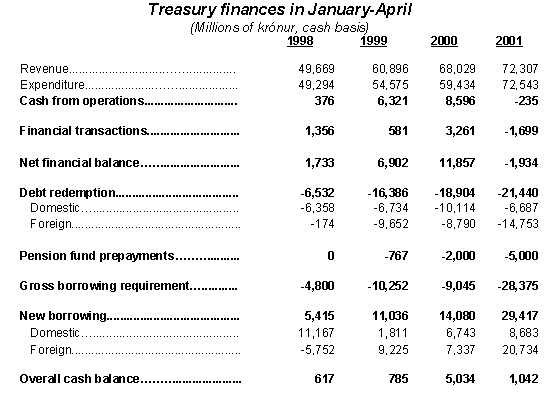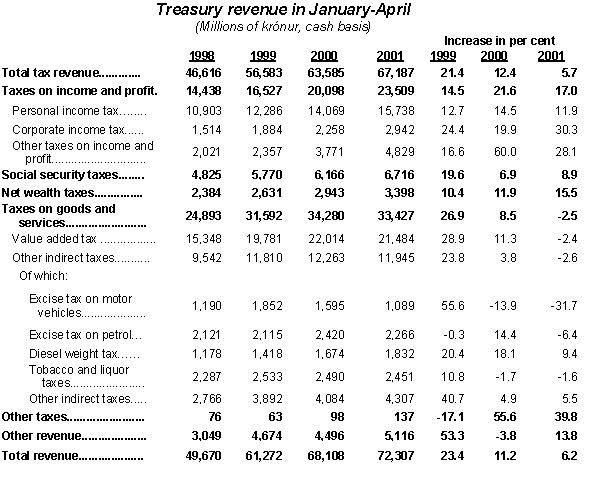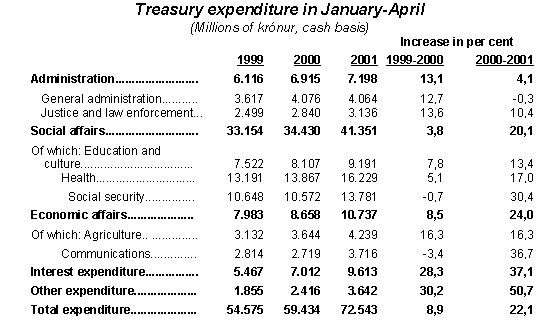Treasury finances January - April 2001. Report date May 23, 2001
Treasury finances, January-April 2001
Report date May 23, 2001
This report is available in PDF-form (160K)
Summary
The cash surplus from operations amounted to a 200 million krónur in the first four months of this year, compared to a surplus of 8.6 billion krónur last year. This result is around 2.4 billion krónur below budget projections. Revenue is close to projections for this period whereas expenditure exceed projections, the largest item being a 1.3 billion krónur payment to disabled pensioners, following a Supreme Court verdict.

Revenues are 4.3 billion higher than in the same period last year primarily due an increase in taxes on wages and profits. Expenditures are 10.3 billion higher than last year, half of which is due to special circumstances. Interest payments increase by 2.6 billion krónur; special payments to the disabled amount to 1.3 billion krónur; 1.1 billion is due to a contribution to improve the cash flow status of the Social Security Administration because of health insurance; government purchase of farm production quotas amount to 0.8 billion and a special increase in contributions to the Municipal Equalisation Fund amounts to 0.9 billion.
The net financial deficit amounted to 1.9 billion krónur, about 3 billion below projections and 13S billion less than a year ago. This result is due to the increase in expenditures mentioned above in addition to the fact that last year the Treasury received a one-time payment of 5.5 billion for the sales of shares in the two state-owned commercial banks. These sales actually took place late in 1999 with payment in early 2000.
A total of 5 billion krónur were paid to the Government Employees Pension Fund in the first four months of this year. This is being done to reduce the future commitments of the Treasury to the Fund. A total of 15 billion is allocated for this purpose in the 2001 fiscal budget.
The overall cash deficit was 800 million krónur for the first four months of the year, compared to a 500 million krónur deficit a year ago.
Revenue
Total revenue of the Treasury amounted to 72.3 billion krónur in the first four months of the year, exceeding projections by 150 million krónur. Revenue exceeded the level of last year by 6.2 per cent. The development of tax revenues is similar; they increased by 5.7 per cent, about half as much as a year ago and about one-fourth of the increase two years ago. Taxes on income and profit are still increasing at a good pace, by 17 per cent between the years. The increase stems mainly from proceeds from the corporate income tax and the capital income tax. Revenue from the personal income tax rises considerably less, or by 12 per cent.

The slowdown in the economy is clearly reflected in the development of indirect taxes that declined by 2.5 per cent in the first four months of this year from the level a year earlier. This development actually reflects a slight contraction in real terms, as inflation has been close to 4 per cent in this period. This is partly explained by a decline in vehicle imports by around 30 per cent in the first four months of this year from last year's level. Petrol taxes are below projections by 280 million krónur, although this could be due to fluctuations from month to month.
The value-added tax, the single largest revenue item, declined by 2.4 per cent from last year. Proceeds from the value added tax from domestic commerce rose by 4.7 per cent and of imports by 9.4 per cent. This is more than offset by the change in the composition of imports, where the relative share of investment and input goods has sharply increased. Such a change causes a commensurate deduction from gross tax proceeds through a rise in the in-tax, thus causing a temporary fluctuation in tax collection, as in this case.
Expenditure
Total expenditure of the Treasury amounted to 72S billion krónur in the first four months of the year, 2S billion krónur in excess of projections, largely because of a one-time payment of 1.3 billion krónur in disability pensions, following a Supreme Court verdict. Expenditure increased by 13.1 billion krónur from the first four months of last year, which is primarily explained by the four items observed above and by increased interest payments of 2.6 billion krónur. Since the period under consideration only covers four months, deviations from projections for individual items may be quite substantial.

Administrative expenditures, which include the Presidency, the Cabinet, the Althingi, the courts and law enforcement, are approximately unchanged from the previous year. Increases in salary payments and general non-salary expenditures are offset by lower outlays for the operation of real property and expenditures connected with the millenium last year. The rise in law enforcement and civil security by close to 300 million krónur is largely due to avalanche prevention investments.
Social affairs. More than half of total expenditures in the first four months went to social affairs including education, culture, health and social security. Expenditures in this category rose by 6.9 billion krónur between the years. Expenditures for education rose by just over 800 million krónur, half of which is due to higher education schools and is in part explained by overtime payments to teachers following the teacher strike at the secondary school level. Shifts in expenditures between months also play a role, explaining a 140 million krónur increase in payments to the University of Iceland and 100 million krónur to the Student Loan Fund. Health expenditures increase by 2.4 billion krónur between the years, of which 900 million krónur is explained by payments to the Social Security Administration which improved its cash balance by 900 million krónur due to an overassessment of payments needed for health insurance outlays. Operational expenditures of hospitals and nursing homes increased by just over a billion krónur and social security outlays increased by 3.2 billion krónur or 30 per cent, 1.3 billion of which, as noted earlier, is due to the Supreme Court verdict to the effect that disability pensions were too low; such pensions were thus increased retroactively for the past four years. Pensions for senior citizens also increased in line with disability pensions, but only with effect from this year. Social welfare expenditures increased by 800 million krónur, mostly due to a shift in outlays between individual months. Outlays to the Unemployment Insurance Fund increase much less, only by 50 million krónur, since the unemployment rate is virtually unchanged from last year. Parental leave benefits in pursuance of the new Parental Leave Benefit Act have led to a 260 million krónur expenditure so far this year.
Economic affairs. Expenditures on economic affairs increased by close to 2 billion or 24 per cent, primarily due to government purchases of farm production quotas, a one-time payment of 780 million krónur in January. Expenditures on communications increased by 1 billion of which 700 million go to roadbuilding and maintenance and close to 200 million to harbours. Contributions to the Institute of Regional Development increased by 300 million krónur.
Interest expenditures increased by 37 per cent or 2.6 billion krónur, 1.8 billion of which is due to the redemption of a large government bond issue and 200 million krónur due to short-term credit from abroad.
Other expenditures increase by 760 million krónur between the years, primarily due to a special increase in the contribution to the Municipal Equalisation Fund.
Capital transactions
The outflow on financial transactions amounted to 1.7 billion in the first four months of this year as against an inflow of 3.3 billion last year. The difference is mostly explained by an in-payment of 5.5 billion early in 2000 due to the above-mentioned sales of shares in state-owned commercial banks.
Repayments of Treasury debt amounted to 21.4 billion krónur, nearly all due to the repayment of a foreign government loan. A large domestic bond issue from 1990 matured in February and the redemption amounted to 8.8 billion krónur, of which 4.8 billion were repayments of principal, the remainder being accumulated interest..
Furthermore, two domestic government bonds issues were redeemed before maturity at an auction for 3 billion of market value, of which 1.8 billion were repayments. Auctions of this kind are directed toward government bond issues that lack liquidity in the secondary market.
The Treasury remitted 5 billion krónur to the Government Employees Pension Fund, as noted above, as against 2 billion in the same period a year ago.
Treasury borrowing amounted to 29.4 billion krónur, 20.7 billion of which was borrowed abroad. This represents the proceeds from a bond issue of 250 million Euros that was used to refinance earlier foreign debt. Treasury bills outstanding increased by 6 billion. In addition, new government bonds with a 6-year maturity were sold for close to 2.5 billion krónur.
